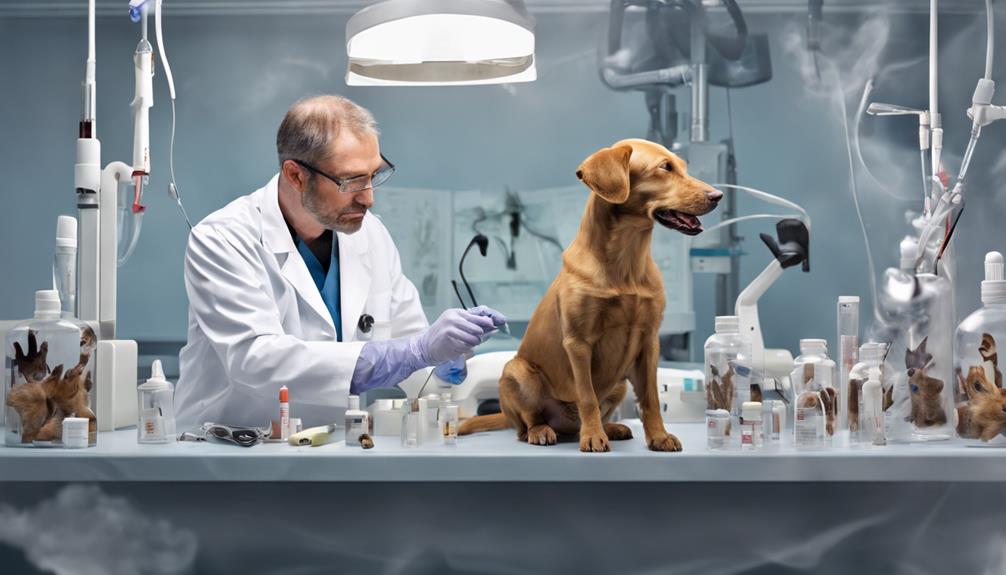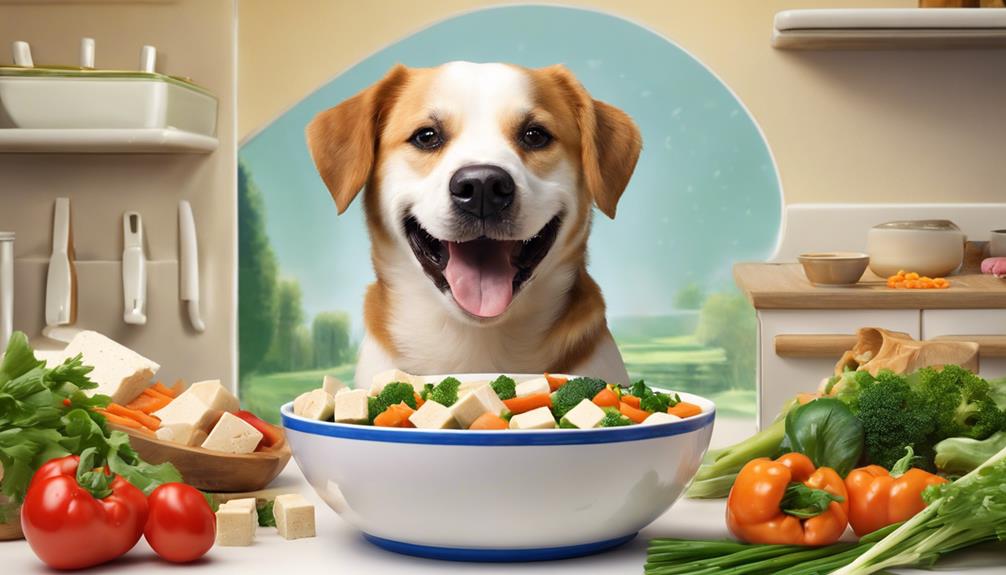Tulips can be harmful to dogs due to toxic compounds in the bulb. Small dogs and puppies are especially at risk. Symptoms of tulip toxicity include drooling, vomiting, and diarrhea. The bulb is the most critical part. Swift veterinary attention is essential if ingestion is suspected. Other toxic plants to avoid are lilies, daffodils, and azaleas. Prevent access to harmful plants, supervise around flowers, and know poisoning symptoms for early detection. If your dog shows symptoms, seek immediate help. Remember, their safety is top priority, and being informed can help protect them.
Key Takeaways
- Tulip bulbs contain toxic compounds harmful to dogs.
- Symptoms of tulip poisoning include vomiting and drooling.
- Immediate veterinary care is crucial for treatment.
- Supervise dogs around tulips to prevent ingestion.
- Educate yourself on toxic plants to protect your pet.
Risks of Tulip Toxicity in Dogs
Tulip toxicity in dogs poses significant risks due to the presence of toxic compounds such as Tulipalin A and B, primarily found in the bulb. When ingested, these compounds can lead to poisoning, especially in small dogs or puppies that may consume larger amounts relative to their size. It's important to be aware of the parts of the plant that are toxic, with the bulb being the most dangerous. If your furry friend shows symptoms like excessive drooling, vomiting, or diarrhea after ingesting tulips, it's important to contact a vet immediately.
Small dogs, due to their size, are more vulnerable to severe tulip poisoning. Puppies, in particular, may be curious and more likely to explore and chew on plants, putting them at higher risk. Recognizing the symptoms of tulip toxicity and acting promptly by seeking veterinary care can prevent serious complications and safeguard the well-being of your pet. Remember, immediate attention is key when it comes to tulip poisoning in dogs.
Symptoms of Tulip Poisoning

Experiencing symptoms of tulip poisoning in dogs can be alarming and requires immediate attention to guarantee the well-being of your furry companion. When a dog ingests a tulip, various signs may appear, indicating potential toxicity. Common symptoms include vomiting, diarrhea, and abdominal pain. Additionally, your dog may exhibit excessive drooling, lack of appetite, and oral irritation, such as redness or blistering in the mouth and throat. In severe cases, tulip poisoning can escalate to difficulty breathing, abnormal heart rate, and even seizures. To help you recognize these symptoms better, we've created a table below outlining the key indicators of tulip poisoning in dogs.
| Symptoms | Description |
|---|---|
| Vomiting | Forceful expulsion of stomach contents |
| Oral Irritation | Redness, blistering, or inflammation in the mouth |
| Abdominal Pain | Discomfort or tenderness in the belly area |
Keep a close eye on your dog for these signs if they have been exposed to tulips, and seek veterinary care promptly if any of these symptoms manifest.
Diagnosis and Treatment Options

After observing symptoms such as vomiting, diarrhea, and oral irritation in a dog exposed to tulips, the next step involves promptly seeking veterinary care for diagnosis and treatment options.
When it comes to diagnosing tulip poisoning in dogs, vets will look for these telltale signs and may conduct tests like blood work and urinalysis to assess the extent of the poisoning.
Treatment options for tulip poisoning in dogs can include inducing vomiting to remove any remaining toxins, administering activated charcoal to bind toxins in the stomach, and providing vital care such as intravenous fluids to prevent dehydration.
Seeking immediate veterinary attention is essential in ensuring the best outcome for your furry friend. Throughout the treatment process, monitoring for complications like dehydration and intestinal blockages is necessary.
Prevention of Tulip Ingestion

To avoid tulip ingestion by dogs, it's crucial to keep tulips out of their reach and consider planting them in areas inaccessible to pets.
Monitoring your dog's environment and supervising them around tulips can help prevent any nibbling incidents.
Using barriers or fencing and positively reinforcing training to deter dogs from approaching tulips are effective strategies to keep them safe from potential toxicity.
Keep Tulips Away
Regularly remind ourselves to keep tulips out of reach of our furry companions to prevent accidental ingestion and potential harm. When it comes to safeguarding our dogs from the dangers of tulips, we can take several precautions:
- Store tulip bulbs securely to avoid accidental consumption by pets.
- Supervise dogs around tulips and discourage them from nibbling on the plants.
- Consider pet-friendly alternatives to tulips in your garden for pet safety.
- Educate yourself on the symptoms of tulip poisoning in dogs for early detection.
- Take proactive measures to keep tulips away from areas accessible to pets.
Train Dog Not to
Let's ensure our furry friends stay safe by training them to avoid ingesting tulips through important reinforcement techniques. When teaching your dog not to eat tulips, use commands like 'leave it' or 'drop it' to redirect their attention. Provide alternative toys or treats to distract your dog from the plants. Remember to supervise closely to intervene if needed. Consistency and patience are essential for successful training. Below is a simple table to help you understand how to train your dog not to ingest tulips effectively:
| Techniques | Description |
|---|---|
| Use Commands | Teach 'leave it' and 'drop it' for redirection. |
| Distract with Toys/Treats | Offer engaging alternatives to tulips. |
| Supervise Closely | Keep a watchful eye and intervene if necessary. |
Monitor Dogs Environment
When overseeing your dog's surroundings to prevent tulip ingestion, make sure that all areas with tulips are secured and inaccessible to your furry companion.
- Guarantee tulips are contained in areas your dog can't access.
- Monitor your dog closely to keep them away from tulips.
- Consider using pet-friendly deterrents to prevent ingestion.
- Train your dog to avoid tulips through positive reinforcement.
- Consult with a vet if you notice any signs of poisoning in your dog's body.
Immediate Veterinary Care Importance

Immediate veterinary care is vital if a dog ingests tulips. This urgency stems from the potential health risks associated with tulip toxicity.
Contacting a vet promptly can help prevent severe symptoms and guarantee the best outcome for the dog.
Urgency of Treatment
Seeking prompt veterinary care is essential if a dog has ingested tulips, as the toxic compounds can lead to severe symptoms that require immediate intervention. When dealing with tulip poisoning, quick action is pivotal to safeguard the well-being of your furry friend. Here's why urgent veterinary care is crucial:
- Delay in seeking treatment can worsen symptoms.
- Symptoms of tulip poisoning can escalate rapidly.
- Professional assessment is necessary for proper treatment.
- Quick action can prevent potential complications.
- Immediate intervention can address issues like dehydration and intestinal blockages effectively.
Potential Health Risks
To guarantee the well-being of our furry companions, immediate veterinary attention is vital when tulip poisoning is suspected due to the potential health risks involved.
Ingesting tulips can lead to dehydration and intestinal blockages in small dogs. Symptoms of tulip poisoning include vomiting, diarrhea, increased heart rate, and breathing difficulties. Tulip bulbs contain the highest concentration of toxic compounds in the plant, posing a severe threat to our pets.
If your dog shows signs of tulip poisoning such as mouth and stomach irritations from eating any part of the tulip plant, seek immediate veterinary care. Delaying treatment can result in serious consequences, including sudden death.
Be vigilant and act promptly to ensure your pet's health and safety.
Critical Care for Small Dogs

When caring for small dogs in critical situations, it's essential to closely monitor their condition and provide prompt medical attention.
Here are some important steps to follow when dealing with tulip poisoning in small dogs:
- Observe Symptoms: Watch out for signs such as vomiting, diarrhea, mouth and stomach irritations, and breathing difficulties in small dogs that may have ingested tulips.
- Seek Veterinary Attention: Immediate professional help is crucial for small dogs displaying symptoms of tulip poisoning to avoid complications.
- Administer Treatment: Treatment may involve inducing vomiting to remove the toxins, using activated charcoal to absorb any remaining toxins, and continuous monitoring by a veterinarian.
- Monitor Closely: Keep a close eye on the small dog's condition and behavior post-treatment to guarantee recovery and address any complications that may arise.
- Prevent Future Exposure: Take precautions to prevent small dogs from accessing tulips or other toxic plants to avoid future incidents of poisoning.
Other Toxic Plants for Dogs

Avoiding harmful plants is vital for safeguarding your dog's health and well-being. Some common harmful plants for dogs include lilies, daffodils, hyacinths, azaleas, peace lilies, and aloe vera. These plants can cause various symptoms like vomiting, diarrhea, drooling, lethargy, and difficulty breathing if ingested by your furry friend.
It's important to be aware of the harmful plants in your surroundings, whether they're houseplants, garden plants, or wild plants, to prevent any accidental ingestion.
To keep your dog safe, make sure to keep harmful plants out of reach and educate yourself about the potential dangers they pose. If you suspect your dog has ingested a harmful plant, seek immediate veterinary help. Remember that prevention is key when it comes to protecting your dog from plant poisoning. By being proactive and informed about harmful plants, you can create a safe environment for your canine companion to thrive in.
Expert Advice on Tulip Poisoning

Expert veterinarians recommend immediate action if you suspect your dog has ingested tulips, as these flowers are toxic to dogs and can lead to serious health issues. When dealing with tulip poisoning in dogs, it's vital to be aware of the following:
- Toxic Compounds: Tulips contain toxic compounds such as Tulipalin A and B, which can be harmful to your furry friend.
- Symptoms: Look out for symptoms like excessive drooling, vomiting, diarrhea, and abdominal pain, as these could indicate tulip poisoning in your dog.
- Vet: Contact your veterinarian right away if you suspect your dog has ingested tulips to get the necessary help and guidance.
- Treatment: Immediate veterinary care is essential for proper treatment of tulip poisoning in dogs.
- Ingestion: If your dog has eaten any part of a tulip plant, including the bulb, it's important to seek professional assistance promptly to prevent further complications.
Recovery Process for Affected Dogs

During the recovery process for dogs affected by tulip poisoning, monitoring their symptoms closely is essential for their well-being. In severe cases, dogs may experience heart problems and difficulty breathing, requiring vital treatment. After receiving care for tulip poisoning, some dogs might have coordination difficulties. It's important to provide a calm environment for rest and recuperation during this time.
Symptoms typically last a few hours post-treatment, so regular monitoring of blood chemistry may be necessary. If you notice any concerning signs or if your dog isn't improving as expected, contacting the vet for advice is important. Remember, the recovery process varies for each dog, so patience and attentive care are key.
Frequently Asked Questions
What if a Dog Eats a Tulip?
If a dog eats a tulip, it can experience symptoms like vomiting, diarrhea, and mouth irritation.
The bulb of a tulip contains the highest concentration of toxins, posing a significant danger to dogs, especially small breeds and puppies.
Severe signs of tulip poisoning may include increased heart rate and breathing difficulties.
Immediate veterinary attention is essential to prevent complications or sudden death in such cases.
Can You Have Tulips in the House With Dogs?
Yes, you can have tulips in the house with dogs, but caution is essential. Tulips are toxic to dogs, causing various health issues. To keep your furry friends safe, place tulips where they can't access them. Consider hanging baskets or shelves out of reach.
If you suspect your dog has ingested tulip parts, contact a vet immediately. Prevention is key in ensuring a pet-friendly environment.
Which Common Flower Is Highly Toxic to Dogs?
Yes, lilies are highly toxic to dogs. Ingesting lilies can lead to severe health issues like kidney failure in our furry friends. It's essential to keep lilies away from dogs to prevent accidental ingestion.
If a dog shows symptoms of lily poisoning such as vomiting or lethargy, immediate veterinary care is necessary to guarantee their well-being.
Are Tulip Petals Poisonous?
Tulip petals are generally not highly toxic to dogs, causing only mild irritation if consumed. However, the bulbs contain more poisons and pose a greater risk. Symptoms of tulip poisoning are usually linked to bulb ingestion.
While petals may not be as harmful, preventing dogs from eating any part of the plant is optimal. It's important to be cautious to protect our furry friends from potential harm.
Can Dogs Safely Eat Tulips?
Tulips are not safe for dogs to eat. In fact, they are toxic to dogs and can cause gastrointestinal upset, drooling, and even more severe symptoms like difficulty breathing or organ damage. It’s always best to keep tulips and other potentially harmful plants out of reach of your pets. Remember, not all dogs can eat sprouts.
Conclusion
To sum up, tulips can be toxic to dogs if ingested, causing symptoms such as vomiting and diarrhea. It's important to seek immediate veterinary care if tulip poisoning is suspected.
Did you know that in a study conducted by the ASPCA, tulips were found to be one of the top 10 plants toxic to dogs?
Remember to keep these beautiful flowers out of reach to keep your furry friends safe and healthy.










